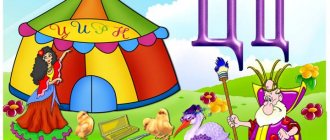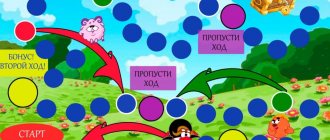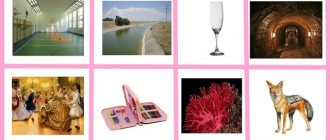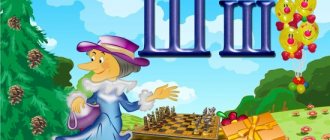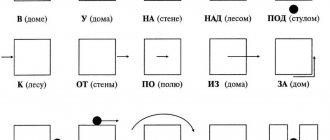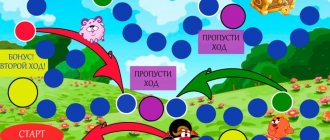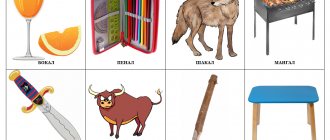Automating the sound “Ш” in words using pictures is the easiest and most accessible way to introduce sound into a child’s vocabulary. In this article you can find verbal and visual material on automating the sound “Ш” at the beginning, middle and end of words.
Before you start working on the sound in words, perform several articulatory gymnastics exercises. This will prepare the speech apparatus and set it up for the lesson. Next, pronounce a chain of syllables with this sound and you can proceed directly to the words.
When pronouncing the sound “Ш”, pay attention to the correct articulation (position of lips, teeth, cheeks).
Articulation of the sound “Ш”:
- lips moved forward;
- teeth are visible and close together;
- the tip of the tongue is raised to the tubercles behind the upper teeth (alveoli), forming a gap;
- the lateral edges of the tongue adjoin the inner side of the molars, forming a longitudinal channel in the middle of the tongue through which a stream of exhaled air passes;
- the entire tongue is tense, the root of the tongue is raised;
- the soft palate is raised. pressed against the upper part of the throat;
- the vocal cords are open, the sound “Ш” is dull;
How to teach a child to pronounce hissing sounds [Ш], [Ф], [Ч], [Ш]
Lyubov Nikolaenko
How to teach a child to pronounce hissing sounds [Ш], [Ф], [Ч], [Ш]
Many parents are concerned about the problem of correct pronunciation of the child's speech sounds . The sounds that a child pronounces are formed thanks to a complex set of movements of the articulatory organs. The older the baby gets, the clearer and more differentiated his articulatory and facial movements become, as a result the child’s speech becomes more and more understandable. Normally, the formation of the correct pronunciation of soft hissing words (ch, sch)
occurs by the age of four , and hard hissing words (w, zh)
by five years.
It is by the senior group of kindergarten (5 - 6 years old) the pronunciation of hissing sounds is considered complete. But in practice, a significant number of children, for a number of reasons (impaired intrauterine development, birth trauma, somatic weakness, physiological disorders of the articulatory apparatus, etc., do not have the skill of correct pronunciation of hissing sounds .
Correct articulation of hissing sounds
Ш - lips are slightly rounded, the tip of the tongue is raised behind the upper teeth, the lateral edges of the tongue are pressed against the upper teeth, the tongue takes the shape of a cup, the voice is asleep, a warm air stream flows through the middle of the tongue. Ш - consonant, hard, dull, hissing
F - the same as sh, only the voice “woke up”
.
The neck is shaking. F – consonant, hard, sonorous, hissing .
H – lips slightly rounded. The tip of the tongue and its back form a closure with tubercles, this closure imperceptibly passes into the gap; between them, a strong, jerky stream of air passes through the middle of the tongue. The sound Ch must be pronounced briefly . The sound Ch is a consonant , soft, dull, hissing .
Sh - lips slightly rounded. The tip of the tongue is raised to the tubercles and forms a gap with them; a warm, smooth stream of air flows through the middle of the tongue. Ш – consonant, soft, deaf, hissing .
Disadvantages in the pronunciation of hissing sounds : interdental, nasal lateral pronunciation . In addition: “lower”
pronunciation of the sounds Ш , Ж
(reminiscent of the sound Ш , absence of hissing sounds and replacement with other sounds .
In order for children's speech to be clear and understandable, it is necessary to work on the development of the muscles of the articulatory apparatus. There are many special exercises for developing mobility of the tongue, lips, cheeks, and hyoid frenulum, which are called articulatory gymnastics. To for your child to do articulation exercises for the tongue and lips, we suggest you use fairy tales. It's time to remember the gnome Tongue and listen to his funny stories. Stories from the life of this gnome are told only while sitting in front of the mirror. What is today's talk about? Everything is very prosaic... The gnome Tongue is having breakfast.
Fairy tale "Breakfast of the Tongue"
“The gnome Tongue stands thoughtfully in the kitchen and can’t decide what to cook for breakfast. Finally, he takes the frying pan. (Exercise “Frying Pan”
: the mouth is slightly open in a smile, the wide front edge of the tongue lies on the lower lip, the lateral edges are raised, a kind of roll is formed along the edge of the tongue.
Hold in this position for at least 10 seconds.) “No, I won’t fry anything!”
The gnome puts the frying pan in the closet.
(Remove your tongue and close your mouth.) “But you can try!”
The frying pan is taken out again and placed on the stove (Exercise
“Frying Pan”
).
Then the Gnome’s gaze falls on the pink cup. “Better tea!”
- Tongue thinks and takes out a cup.
(Exercise “Cup”
: the mouth is open, a wide tongue with highly raised edges is located near the upper teeth. It is important that the lower lip does not
“pull”
the tongue, and it is held in this position on its own for at least 10 seconds.)
At this time the doorbell rings. Friends came. For everyone, you need to get a cup from the cupboard. (The “Cup”
is performed as many times as there are friends who come to the gnome.)”
It’s simply wonderful if the baby performed both of these exercises correctly the first time. What if there are problems? For example, it is not possible to make the language broad. You’ll have to simplify the exercise and punish the naughty tongue by spanking it with your teeth “ta-ta-ta-...”
and lips:
“five-five-five-...”
(Exercise
“Kneading the dough”
).
Finally, the tongue spread out and obediently lay on the lower lip. Now is the time to bake the pancakes. (Exercise “Pancake”
: hold the wide tongue on the lower lip in a calm state for at least 10 seconds, it is important to ensure that the lower lip does not strain or pull on the lower teeth.) We bake pancakes in sufficient quantity: there should be enough for everyone!
Make sure that they are of the correct rounded shape with smooth edges. Oh, how delicious! Let's lick our upper lip with pleasure. But not from side to side, but with a wide tongue from top to bottom. Once again. And one more thing (Exercise “Delicious jam”
: smile, open your mouth; with your tongue in the shape of a cup, lick your upper lip from top to bottom (you can lubricate it with jam; the lower lip should not fit your teeth
(you can pull it down with your hand)
. Let’s hope that with one we have dealt with the problem: the tongue
has learned to be wide . We move on to the next stage: we will teach the tongue to hold on to the upper teeth. But this is the next story:
The fairy tale “A brave rider is picking mushrooms”
“The gnome Tongue loves to ride a horse. He takes the reins in his hands and skillfully controls his horse. (Exercise “Horse”
: loudly
“click”
the tongue, while the lower jaw should be motionless.) At first the horse gallops slowly, then faster and faster.
Where is our brave rider heading? In the forest. How many mushrooms are there! Here is a strong little boletus hiding under the tree. (Exercise “Mushroom”
: a wide tongue is sucked with its surface to the palate. The upper part of the tongue is a mushroom cap, the hyoid frenulum is a leg. Stretch it as much as possible, while opening the mouth wide. Make sure that
the child does not just raise the tongue up, but sucked it to the palate! Hold in this position for at least 5 seconds.) The gnome cut off the fungus (lower the tongue to the bottom of the mouth)
and immediately saw a pink wave (make
“Mushroom”
, holding the tongue in this position for at least 8 seconds) .
In a clearing near a young aspen tree there grew two bright red fly agarics. Their hats were so big! The fly agarics swayed on their thin legs, and it seemed that they were about to fall. (Child and adult make “Mushroom”
and hold their tongue as long as possible. There is a kind of competition going on: whose fungus will last longer.) The gnome did not take fly agarics: they are poisonous! But he collected a full basket of other mushrooms: porcini, boletus, aspen, saffron milk caps (perform the exercise several more times
“ Fungus
"
I must say that the “Mushroom”
It’s quite complicated, and not every kid can do it the first time.
Surely, the shape of the “hat”
will not be round; the tongue will not stick to the palate with its entire surface, but only with the tip.
You will have to return to the “Horse”
and ask
the child not to “snap”
the tongue during
the “clatter”
(get stuck)
as long as possible .
It should work! Each time the “stuck”
is extended.
What kids like most is the Focus
.
This is a very effective exercise. It has been used by speech therapists in the production of hissing sounds for a long time . cup-
shaped ) tongue out of your mouth, lift its front edge towards your nose, but under no circumstances press it against your upper lip!
There is a gap between the tongue and the upper lip. The lips are stretched in a smile, the lateral edges of the tongue touch the corners of the mouth. While the child is building this complex structure, you place a piece of cotton wool on the tip of his nose. And now the baby must blow on the cotton wool without losing the shape of his tongue. The fleece flies upward. If this does not happen , it means that the air stream went in the wrong direction, for example, to the corners of the mouth, or to the cheeks. Or maybe the baby couldn’t hold his tongue, and it “crawled”
into his mouth.
... It is necessary to give the tongue the correct form again. This may take more than one lesson. Patience, and again patience. The air stream is very important when staging hissing ones . But the path it takes is no less important. Normally, on the sounds Ш , Ж, the air flows strictly in the middle of the tongue. You should also pay attention to the lower lip. It sometimes gets in the way: it tucks under the lower teeth, tenses too much, and “pushes”
the tongue.
Such “disservices”
will have to be abandoned.
Lips play an important role when pronouncing sibilants . They should stretch forward with their proboscis
.
But it is not possible to give such a shape to the lips right away. You will have to resort to articulation exercises again: “Donut”
: close your teeth, round your lips extended forward, the corners of your lips do not touch, your lips do not cover your teeth, hold your lips in this position for a count of 5-10;
“Trunk”
: stretch your lips forward like a tube, teeth open.
If you want to correct speech defects that have arisen in your baby, then articulatory gymnastics should be carried out daily. The child should perform these exercises in front of a mirror, and under adult supervision. You must first work through all the exercises yourself and be prepared to patiently demonstrate them to your baby countless times.
Setting sounds [Ш] , [Х]
After the above exercises are performed by the child easily and naturally, it is worth taking up the production of the hissing ones . It’s unlikely to do without a game here. Hissing is the privilege of a snake. Therefore, it is worth depicting it using... a hand. She will be the snake: the hand is the head, everything else is the flexible body. Here is the "snake"
crawls on the table.
Then he raises his head, makes a stand (resting on his elbow, pulls his head forward, and, opening his mouth, hisses: “Sh-sh-sh...”
. At the same time, it is worth drawing
the child’s attention to the fact that the tongue - the “cup”
is raised up, and the lips are pulled forward like a tube. If this is a problem, use your thumb and forefinger to lightly press on the cheeks in the area of the corners of the mouth, giving the lips a
“tube”
. Let the baby pretend to be a snake again and hiss. Is it really a failure again? Don’t despair. Help will come again handle of a teaspoon. If
the child pronounces the sound [C] clearly , let him reproduce it , and at this time you bring the handle of the spoon under the tongue, lift it up to the palate and push it back a little. Be careful not to press too hard on the tongue. It turned out "Rejoice with your child at the clear sound [SH-SH-SH-SH]. Together with your child, remember where else you can hear this sound ?
- the hiss of air coming out of the tire;
- the forest rustles in the wind;
— the mouse scratches under the floor ;
- the hiss of an angry cat;
- rustling of autumn leaves underfoot, etc.
The child all this using the sound [Ш] .
Correcting defects in the pronunciation of the sound [Zh] with acquired articulation [Ш] does not cause difficulties. The child is asked to pronounce the drawn-out sound [Ш] and “turn on”
voice.
This is first done by the adult himself, bringing one of the child’s hands to his mouth and putting the other to his throat (to feel the vibration)
. It’s time to pretend to be a good bug and buzz:
“J-J-J-...”
.
In addition to beetles, this sound is made by :
- bumblebees,
— working electric motors
If the sound [Ш] , there are usually no deficiencies in the pronunciation of [Ш] and [Ч], with the exception of more complex cases in which it is necessary to consult a speech therapist.
It is important to know: you should follow the dosage of breathing exercises, as well as exercises related to the production and automation of sound [Ш] , as they are quite tiring for the child and can cause dizziness due to hyperventilation.
Automation of hissing sounds in a child’s speech
Automation of sounds - consolidation of correct pronunciation by gradually introducing a given sound into syllables , words, sentences, phrases, poems, nursery rhymes, tongue twisters, texts and the child’s independent speech. In automation classes, an exaggerated, longer and clearer pronunciation of the automated sound . Invite your child to play (with sounds , with words, don’t tell him “Let’s do it”
.
For classes with children, it is advisable to use illustrated literature on automating hissing sounds .
When the child correctly pronounce the sounds Ш , Ж, Ш, Ш in independent speech? Even the most highly qualified speech therapist will not give you an accurate answer to this question. For one child, lessons from 2-3 months to six months will be enough; for another child, even a year will not be enough to learn to speak clearly . This depends on the individual characteristics of the child, his structure of the articulatory apparatus, and, ultimately, on the desire of the child himself to do this. Well, if problems arise, speech therapists are always ready to help you.
Helpful Tips:
- At the beginning of each sound automation lesson [Ш], we conduct 2-3 articulatory gymnastics exercises.
- During the lesson, pay attention to the correct articulation of the sound [Ш] (see articulatory gymnastics).
- We pronounce the words slowly, clearly emphasizing the sound [Ш]. Repeat words 2-3 times.
- Classes are held regularly for 20-25 minutes depending on the age of the child and alternating play exercises.
- At the first signs of fatigue, take a physical minute. Kinesiological exercises are very useful for relieving tension and emotional relaxation.
- Classes should be conducted in a friendly and comfortable environment for the child.
For greater efficiency, the sound [Ш] in words is automated sequentially: first we conduct classes on automating the sound at the beginning of words, then in the middle and at the end of words.
Automation of the sound “Ш” in words using pictures will become accessible to you. You just need to download the pictures in A4 format, cut them into cards, preferably laminate them for long-term use and have fun with them.
I would like to note that preschool age is a time of play activity. Therefore, it is better to play out all the tasks, come up with surprise moments, and then the child will be less tired and will study with pleasure. I offer you some game options. With their help, you will not only introduce the sound “Ш” into your baby’s speech, but also develop his grammatical structure.
Letter P
Incorrect pronunciation of the letter P is quite common.
If you do not work on your pronunciation, this defect can remain for life. There are several options for incorrect pronunciation of the letter R:
- children may not pronounce this sound at all (cow - koova),
- there may be a replacement of the hard letter P with a soft one (hand - ryuka),
- sometimes the letter P is replaced by other letters (ruka-luka, duka, luka, yuka, etc.).
How to work with a child to teach him how to correctly pronounce the letter R?
- Articulation exercises will prepare the muscles of the lips and tongue for exercise. They need to be done daily.
- "Jam". The child should open his mouth slightly and move his tongue left and right along his upper lip. To interest your baby, you can put something sweet in your mouth.
- "Painter". You need to move your tongue back and forth across the roof of your mouth, just like a painter does with his brush.
- "Mushroom". The child needs to open his mouth, smile and press his tongue completely to the palate, holding it for 3 to 10 counts.
- Breathing exercises will help you direct the air stream with the right intensity to get the right sound. Inhalation should be strictly through the nose, and exhale through the mouth. There is no need to repeat the exercise more than 4 times.
- "Candle". You need to blow out the burning candle. This can be done with a short, strong stream of air, or, on the contrary, with a weak one. Or blow it from close range, increasing the distance each time.
- "Snowflake". The child should stretch his lips in a smile and place his tongue on the lower lip. You need to blow off a piece of paper (“snowflake”) on the tip of your tongue.
- "Storm". You will need a glass of water and a straw. The child needs to exhale into a tube lowered into a glass. This will create a real “storm” in the water.
- Vibration with the tongue - learning to feel and reproduce.
You need to sit down with your child in front of the mirror. He should see the position of the adult's tongue and lips. This will make it easier to repeat the correct sound. It’s worth trying to pronounce the letter R by roaring like a tiger or purring like a cat. The exercises will be more effective if the child is interested in completing the tasks.
You can learn to pronounce the letter R using other letters. For example, a child can pronounce the sound Z in a drawn-out manner while holding his tongue in the upper position. Then you need to quickly run your tongue along the tubercles behind the upper jaw. The sound will be SR.
You can also work with other letters. For example, learning to pronounce R through well-practiced D, F, S. Gradually, you will be able to get rid of unnecessary letters by automating the pronunciation of the letter R. To do this, you need to often use words in your speech that contain the problematic letter R.
Games with the letter R
To consolidate the effect of the exercises, it is important to return to practicing skills throughout the day.
- "Magic bag" Children take out objects or pictures with images of objects from the bag. You must pronounce the name of the object, clearly pronouncing the letter R.
- Games with cereals. They stimulate fine motor skills well, and therefore speech. You can depict objects whose names contain the letter R. For example, the crown from the grRRRRRiver.
- Repeat the syllable in reverse. Ar-ra, ur-ru, etc.
- Finish the sentence. You will need pictures with hints. For example, ro-ro-ro - feather.
- Short songs or poems. For example:
Lamb, lamb, show me your horns. I'll give you sugar, a piece of pie!
Tongue twisters with the letter P
- The red crab shouts "Hurray!" It's time to cut the cake.
- The crow missed the little crow.
- Karl stole corals from Clara, and Clara stole a clarinet from Karl.
- There is grass in the yard, there is firewood on the grass. Don't cut wood on the grass in your yard.
- Three magpies chattered on the slide.
- The angry crocodile is irritated and unsociable.
- Thunder struck - a thunderstorm was in full swing.
- Borya gave Ira Toffee. Ira Bore - barberry.
- Thirty-three trumpeters sound the alarm.
Speech material:
The sound “Ш” at the beginning of a word:
- sorrel, happiness, happy;
- pike, probe, tentacles, feel, puny, squint, pike;
- rubble, chirp, chirp, goldfinch, flaunt, generosity, bounty, generous, cheek, cheeky, latch, tickle, tickle, tickle, crevice, crevice, click, puppy, sliver, pinch, pinch, chipped, chipped, stubble, generosity, cabbage soup;
- click, lye, dandy, tickle, click, lye, brush, cheek, count, abacus, count, count;
- cabbage soup, ankle, pinch, tongs, tweezers, shield, thyroid gland, shield;
The sound “Ш” in the middle of a word:
- grove, square, platform, forgive, mercy, squeaked, drag, food, philistinism, promise, treat, rotate, hinder, turn, return, boardwalk, squeak, thick, grove, mother-in-law, forest, squeak;
- thicket, click, latch, still, latch, paved, condensed, condensed milk, rattle, slums;
- calculation, miscalculation, counting;
- search, drag, shine, splash, touch, clean, thicket, treat, seek, food, whistle, clean, forgive, rinse;
- look, things, drag, box, vegetables, bream, ticks, in a box, squeaks, groves, help, drags, seeing, ticks, walking, crack, seething, boiling, buzzing, smoking, trembling, holding, speaking, looking, seeing , lying, jumping, drinking, flying, protection, protector, boiling, prophetic, future, running;
- from vegetables, koschei, forgiveness, pinch, clothespin, cave, bloodhound, gorge, treat, rotation, forgiveness, pinch, catering unit, food store, food, cave, dwelling, lizard, simpler, treat, future, torso, storage;
The sound "Ш" at the end of a word:
- bream, thing, cloak, vegetable, tick, ivy, help, power, horsetail, borscht, cartilage, pimple, help, comrade;
The sound “Ш” in a combination of consonants:
- predator, graceful, helper, powerful, vegetable, essential, general;
- bathhouse attendant, burglar, museum attendant, sawyer, sitter, diver, washer, cleaner, mason, racer, inventor;
Letter Z
Learning to pronounce the letter Z will be easy if the child already knows how to say the letter Sh. The fact is that the movements of the tongue and lips when pronouncing them are almost the same. Only when pronouncing the letter Z are the vocal cords still actively activated.
This difference is easy to notice even for a child. Let him place his palm on the throat of an adult who pronounces the letters Ш and Ж in turn. The child will feel how the vocal cords vibrate when they say the letter Ж. When pronouncing the letter Ш, they will remain motionless.
Pay attention to how to pronounce the letter Z correctly. The lips should be rounded and the teeth should be close to each other. The wide tip of the tongue is close to the alveoli (recesses in the bones of the upper jaw), the edges of the tongue are pressed against the lateral teeth, and the back of the tongue is raised and tends back. A warm stream of air passes through the middle of the tongue. The vocal folds are tense and give voice.
Articulation and breathing exercises are suitable for classes. They also develop and prepare the lips, tongue and breathing for pronouncing the letter Z.
Games with the letter Z
- Buzz like a beetle, bee or fly.
- "Bees collect honey." Participants imagine themselves as bees and buzz while spinning and moving around the room. At the signal, you need to “fly away” to the “house” as quickly as possible.
- "Flies in the Web." The game is suitable for a group of children. Some of them depict a web, forming a circle. The other part of the children are “flies”; they run in and out of the circle, buzzing as they do so. At the signal, the “web” children join hands, and those “flies” that did not have time to get out of the circle also get into the web. The game lasts until all the flies are caught.
- “Who needs this?” An adult shows the child story pictures with missing objects. Then you need to take out an object picture and ask what is depicted on it (objects whose names contain the letter Z). For example, a picture of scissors. The child says the name out loud and decides which story picture lacks scissors. For example, grandma needs them to sew.
Tongue twisters with the letter Z
- Zhenya and Vika are chewing blackberries.
- Hedgehogs and grass snakes lived in the living corner.
- It's hot for a toad in a warm puddle. The toad waits for the rain and grieves.
- What do hedgehogs have for dinner? Acorn peel.
- The snake has a bite, the hedgehog has a hedgehog.
- Little Matryoshka's earrings have disappeared. Earrings I found an earring on the path.
- The hedgehog is lying by the Christmas tree, the hedgehog has needles.
- On the roof of Shura lived the crane Zhura. The crane Zhura lived on the roof of Shura.
Visual material:
Letter L
This is one of the most difficult letters to pronounce. Children learn to pronounce it one of the last. However, it is important to start working on correct pronunciation as early as possible.
How to pronounce the letter L correctly?
The lips stretch into a smile, and the teeth are clenched. The tongue can rest against the teeth, the gap between the upper and lower teeth, or the alveoli. The sides of the tongue do not interfere with the free passage of the air stream.
There are several options for incorrectly pronouncing the letter L.
- complete absence of this sound (spoon-spoon)
- replacing with a simpler sound, for example, U
- distorted pronunciation (similar to S, J or R)
- inability to distinguish between hard and soft L.
It is worth trying the following articulation and breathing exercises :
- «Smile". Keep your lips stretched out in a smile, counting to 10. Your mouth should be closed.
- «Locomotive". The lips stretch into a smile, the teeth are clenched, the tongue presses on the teeth, like on a locomotive whistle, and adds a voice. This produces the sound L.
- «Dog". The child stretches his lips in a smile, shows his teeth and bites the tip of his tongue. Then you need to start breathing like a hot dog. It is important to ensure that the air passes through the mouth and not through the nose. Then you need to connect your vocal cords and pronounce YYY or AAA. There is no need to puff out your cheeks.
- «Horse." Smiling widely and showing your teeth, you need to click your tongue (as if a horse is galloping). The lower jaw should remain motionless.
- Move your tongue in your mouth alternately to the right and left.
- «The breeze is blowing." The lips stretch into a smile, the mouth opens slightly and the tongue is bitten. The child begins to blow on the cotton wool in the palm of the adult.
- «Pencil". You need to take a deep breath through your nose and exhale a stream of air through your mouth so that you can roll a pencil across the table.
Games with the letter L
- “Say the sentence.” These can be rhyming sentences that you need to come up with yourself (for example, lo-lo-lo - it’s warm outside). The child can also continue the lines of poems known to him (for example, A. Barto “The Little Frogs”).
- "Box of Pictures" Let the child name the objects shown in the pictures (the names of which contain the letter L). Then you need to make a sentence out of these few words. For example: a bowl of raspberries and a lamp are on the table.
- "What's missing?" On the table there are objects whose names contain the letter L (spoon, boat, frog, etc.). For a few seconds, the child turns away from the table, and the adult hides the object. You need to name the “missing” thing.
- Rhymes and songs.
It ran away, it ran away, the milk ran away. I caught it with difficulty, Being a mistress is not easy!
Grandfather planted onions and grew an onion. The grandson saw the bow and tore off the forelock of the bow. An amazing thing: Tears are falling - from the grandson!
Here are the needles and pins crawling out from under the bench. They look at me, they want milk.
Tongue twisters with the letter L
- Lena was looking for a pin, and the pin fell under the bench.
- On the river shallows we came across a burbot.
- There is no ring near the well.
- The Queen gave the gentleman a caravel.
- Our Polkan from Baikal lapped. Lakal, lakal, but Baikal did not become shallow.
- Mom washed Mila with soap.
- Antipas had one linden tree, but Philip planted seven linden trees.
- Crucian carp, don't get into the hole! A crucian carp got stuck in a hole.
- Karl was putting the onion on the chest. Clara was stealing onions from the chest.
Game options:
"Name and Repeat"
Lay out one card with the sound [Zh] (pre-print and cut the cards, they are presented above) and offer to name them. If it is difficult for a child, help him by correcting incorrect pronunciation of sounds.
“What’s missing?”
Lay out 4-5 cards with the sound [Zh] (depending on age) in front of the child, naming them correctly. You give instructions that the pictures must be remembered. When the baby closes his eyes, remove one card and ask: “What’s gone?” (the Beetle is gone , the Toad is gone, etc.). In this game you can change places with your child, because he is also interested in being in the role of a teacher.
"What changed?"
Place 4-5 cards with the sound [Zh] , naming them correctly and asking them to remember. The child closes his eyes, you swap the pictures. Then ask to find changes.
"The Fourth Wheel"
For this game, you take cards with the sound [F] , as well as additional ones for other sounds (you will find them in the gallery just below). Lay out 4-5 pictures in front of the baby, naming them together. Ask the child to name the extra card in the row (for example, toad , paw, beetle , well . Extra card PAWS, there is no sound [F]).
"One-many"
For this game, it is necessary to use the “One-Many” model (you will find the model in the gallery below) so that the child has support for clarity. Explain to the child that by applying a card to an image with one circle there is one object, to an image with many circles there are many objects (for example, a beetle - many beetles, a vest - many vests, a knife - many knives). Don't forget to pronounce words correctly!
"Big small"
This game is also played using a model. You will find the “Big - Small” model in the gallery below. The game is played by analogy as “One - many”. Apply the card to the large circle - BUG, to the small circle - BUG.
"Let's count"
The game “Let's count” will teach the child to correctly agree nouns with numerals in gender and number. It is also carried out according to the model (see gallery). The numbers in the model are of different colors: 1 is green, 2, 3, 4 are blue, 5 is red. The colors will help draw the child’s attention to changes in endings in words (one is toad , but two, three, four are toad , five is toad ). Explain this rule to your child and watch the endings of words.
Automating the sound “Ш” in words using pictures is the easiest and most accessible way to introduce sound into a child’s vocabulary. In this article you can find verbal and visual material on automating the sound “Ш” at the beginning, middle and end of words.
A small digression. Sound or letter?
Sound and letter are inseparable from each other. But often even adults confuse these concepts, not understanding the difference between them.
In fact, everything is very simple. What we speak and hear are the sounds of the Russian language. And what we see and read in a book, notebook, computer monitor are letters.
Children first learn to reproduce sounds (speak) and only then begin to write letters (denote what is said graphically).
But due to the fact that we are almost always asked the question: “How to teach a child to say the letter R or the letter Sh?”, we believe that the difference between the letter and the sound in this case is not fundamental. For ease of understanding and reading the article, we chose a single and The term “letter” is familiar to most readers.
